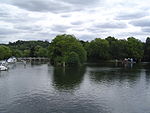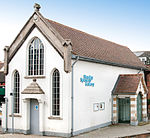Formosa Island

Formosa Island is an island in the River Thames in England at Cookham Lock near Cookham, Berkshire, with two smaller adjacent islands. The island is one of the largest on the non-tidal river Thames with 50 acres (20 ha) of woodland. It can be reached by footbridge from Cookham. It is between two of the four channels in the river at Cookham, the one closest to Cookham was once the mill stream to a paper mill at Cookham. The one on the other side leads to Odney Weir. The adjacent Mill Island has the lock channel on the other side. Beyond the lock channel is Sashes Island and the channel furthest from Cookham is Hedsor Water, the original navigation channel, which was blocked by the weir in 1830 when the lock was opened, causing loss of trade to then owner Lord Boston.
Excerpt from the Wikipedia article Formosa Island (License: CC BY-SA 3.0, Authors, Images).Formosa Island
Odney Lane,
Geographical coordinates (GPS) Address Nearby Places Show on map
Geographical coordinates (GPS)
| Latitude | Longitude |
|---|---|
| N 51.56 ° | E -0.699 ° |
Address
Odney Common
Odney Lane
SL6 9SS
England, United Kingdom
Open on Google Maps









